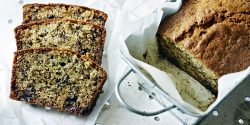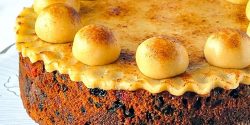
Mary Berry lasagne has been perfected over many years and is a true classic. It stands as a testament to her skill in creating delicious and comforting dishes
She recommends leaving the lasagne to stand for six hours before cooking to allow the pasta sheets to soften . If you’re looking for something even simpler and quicker you should look at Mary Berry express lasagne recipe.
2 hours
30 mins to 1 hour
Serves 6-8
 Mary Berry recipes
Mary Berry recipes
By Mary Berry
Equipment needed to make Mary Berry’s lasagne
- Large heavy-based frying pan
- Wooden spoon
- Medium saucepan
- Whisk
- Shallow ovenproof dish (2.3 litre/4 pint capacity) – Amazon’s Choice
- Measuring spoons
- Measuring jug
- Grater
- Kitchen scales – check out Amazon’s Best Seller
Ingredients
For the ragu
- 2 tbsp olive oil
- 900g/2lb minced beef
- 2 onions, roughly chopped
- 4 sticks celery, diced (optional)
- 2 garlic cloves, crushed
- 2 level tbsp plain flour
- 150ml/¼ pint beef stock
- 1 tbsp redcurrant jelly (optional) or 1 tsp sugar
- 3 tbsp tomato purée
- 1 tbsp chopped thyme
- 2 x 400g/14oz cans chopped tomatoes
For the white sauce
- 50g/2oz butter
- 50g/2oz plain flour
- 750ml/1¼ pints hot milk
- 2 tsp Dijon mustard
- 50g/2oz Parmesan cheese, grated
- To taste salt and pepper
For the lasagne
- 10–12 lasagne sheets
- 75g/3oz mature cheddar cheese, grated
Method
Step 1: Prepare the Ragu
- Preheat your oven to 160°C (140°C for fan ovens) or Gas Mark 3.
- In a large, heavy-based frying pan, heat 2 tablespoons of olive oil over high heat until it’s shimmering.
- Add 900g of minced beef to the hot pan. Break it up with a wooden spoon and cook until thoroughly browned, stirring frequently. This should take about 5-7 minutes. Once browned, remove the beef from the pan and set aside on a plate.
- In the same pan, reduce the heat to medium and add 2 roughly chopped onions, 4 diced celery sticks (if using), and 2 crushed garlic cloves. Sauté for about 5-7 minutes until the vegetables are soft and translucent, stirring occasionally.
- Return the browned beef to the pan and sprinkle 2 level tablespoons of plain flour over the mixture. Stir well to coat the meat and vegetables, cooking for about 1 minute to remove the raw flour taste.
- Gradually pour in 150ml of beef stock, stirring constantly to prevent lumps from forming. Bring the mixture to a boil.
- Add 1 tablespoon of redcurrant jelly (or 1 teaspoon of sugar), 3 tablespoons of tomato purée, and 1 tablespoon of chopped thyme. Stir to combine.
- Pour in two 400g cans of chopped tomatoes and bring the mixture back to a boil, stirring well.
- Cover the pan with a tight-fitting lid or foil and transfer it to the preheated oven. Let it simmer for 1½ hours, or until the beef is tender and the sauce has thickened.
Step 2: Make the White Sauce
- In a medium saucepan, melt 50g of butter over medium heat.
- Once the butter has melted, add 50g of plain flour and whisk continuously for one minute. This creates a roux, which will thicken the sauce.
- Gradually add 750ml of hot milk, whisking constantly to prevent lumps from forming. Continue whisking until the sauce thickens and becomes smooth.
- Stir in 2 teaspoons of Dijon mustard and 50g of grated Parmesan cheese until fully incorporated.
- Season the sauce with salt and pepper to taste. Remember, the cheese adds saltiness, so be cautious with additional salt.
Step 3: Assemble the Lasagne
- In a 2.3 litre (4 pint) shallow ovenproof dish, begin layering your lasagne:
- Spread 1/3 of the meat sauce evenly across the bottom of the dish.
- Pour 1/3 of the white sauce over the meat sauce and spread it evenly.
- Season lightly with salt and pepper.
- Place a single layer of lasagne sheets on top, breaking them if necessary to fit the dish.
- Repeat the layering process:
- Add 1/2 of the remaining meat sauce.
- Pour 1/2 of the remaining white sauce over the meat.
- Season lightly with salt and pepper.
- Add another layer of lasagne sheets.
- For the final layer:
- Spread the last of the meat sauce.
- Pour over the remaining white sauce, ensuring it covers the entire surface.
- Sprinkle 75g of grated mature cheddar cheese evenly over the top.
- Allow the assembled lasagne to rest at room temperature for 6 hours. This resting period allows the pasta sheets to soften and absorb the flavours of the sauces.
Step 4: Bake the Lasagne and Serve
- Preheat your oven to 200°C (180°C for fan ovens) or Gas Mark 6.
- Place the lasagne in the middle of the preheated oven and bake for approximately 45 minutes. The top should be golden brown, the edges should be bubbling, and the pasta should be soft when pierced with a knife.
- Once baked, remove the lasagne from the oven and let it rest for 10-15 minutes before serving. This will make it easier to cut and serve neat portions.
What can you serve with Mary Berry lasagne
- Garlic Bread – The crispy, buttery texture provides a perfect contrast to the soft, rich lasagne and helps mop up any delicious sauce left on the plate.
- Mixed Green Salad – A fresh, crisp salad with a light vinaigrette cuts through the richness of the lasagne, providing a refreshing counterbalance to the heavy meat and cheese.
- Roasted Mediterranean Vegetables – Zucchini, bell peppers, and aubergine roasted with olive oil and herbs offer a light, nutritious side that complements the lasagne’s robust flavour’s.
- Coleslaw – The tangy, crunchy slaw provides a cool, fresh element that contrasts beautifully with the warm, hearty lasagne.
- Crusty Sourdough Bread – Perfect for soaking up any remaining sauce and adding an extra textural element to the meal.
Suggested Wine Pairing for Mary Berry Lasagne
Here are three options from popular UK retailers that offer great value and taste:
Majestic: The Gabb Family Malbec 2020
This South African Malbec offers a delightful combination of smoky notes, warm cinnamon spiciness, and strawberry fruit flavours. Its robust character and grippy tannins make it an excellent match for the rich, meaty layers of lasagne. The wine’s freshness will cut through the dish’s creaminess, while its fruity notes will complement the tomato-based sauce.
Tesco: Finest Cahors Malbec
This French Malbec from the Cahors region provides a traditional pairing for lasagne. It features aromas of old leather, dark fruit, and violets. On the palate, you’ll find robust dark fruit flavours with grippy tannins, balanced by a pleasant freshness and fragrance. This wine’s structure and depth will stand up well to the complex flavours of lasagne, particularly complementing the beef and tomato sauce.
Sainsbury’s: Taste the Difference Barbera d’Asti
Barbera is a classic Italian grape that pairs wonderfully with lasagne. This wine likely offers bright acidity, which will cut through the richness of the cheese and béchamel sauce. Expect flavours of ripe cherry and plum, with a hint of spice. The wine’s medium body and juicy character make it an ideal companion to the layers of pasta, meat, and sauce in your lasagne.
At the time of publishing this article, these wines, all priced under £12.50, offer excellent value and are specifically chosen to enhance your lasagne experience. Their combination of acidity, fruit flavours, and structure will complement the dish’s rich, savoury profile, creating a harmonious dining experience.
Mary Berry Lasagne FAQs
What’s Mary Berry’s secret to a good lasagne?
There’s a bit of magic in the details. Her béchamel is extra silky thanks to Dijon mustard and parmesan, and she lets her ragu simmer until it’s packed with flavor. The real trick, though? She builds the lasagne and lets it rest for hours before baking. The pasta soaks up all that sauce, and you get neat slices instead of a wobbly mess. (And if you’re feeling retro, you could try frying your meat and veg in dripping, like Mary did on TV in the ‘70s. Most of us stick with olive oil these days.)
Should you pre-cook pasta sheets before assembling lasagne?
If you’re working with fresh pasta, skip the boiling. For dried sheets, Mary’s method is a lifesaver – no pre-cooking needed as long as you’ve got enough sauce and a little patience for that resting time. If you’re short on sauce or in a rush, though, you might want to give those sheets a quick dip in boiling water so you don’t end up with chewy bits.
What’s the right way to layer lasagne?
There are a million ways, and everyone’s got an opinion. Mary usually starts with Bolognese, then white sauce, then pasta. Some folks sneak in extra pasta layers for more structure. The only real rule? Finish with béchamel and a generous blanket of cheese on top.
How many layers are we talking?
Three is the bare minimum for a real lasagne experience, but four or five is where the party’s at. Stack it high if you’re feeling bold.
Cheese in every layer – yes or no?
Totally your call. If you want every bite to be gooey, sprinkle a bit of cheese on top of each white sauce layer. Mary’s main move is to pile it on at the end.
Does Mary Berry put egg in her lasagne?
No eggs here. Her white sauce is all about butter, flour, hot milk, Dijon, and parmesan. No sneaky eggs in the mix.
What kind of pasta does Mary use?
She’s a fan of dried, no-boil lasagne sheets. They’re easy and, with her method, they soften up beautifully. Fresh pasta works too, but you don’t need to fuss with it.
Should you bake lasagne covered or uncovered?
Depends on your mood. Covering with foil keeps things soft and saucy. If you’re after those crispy corners, whip off the foil for the last 15 minutes. Some people do both—foil on for most of the bake, then off for the grand finale.
How long does it need in the oven?
About 45 minutes at 200°C (or 180°C if you’ve got a fan oven). You’re looking for golden, bubbling, and irresistible.
How long do you have to wait before slicing?
This is the hardest part. Give it about half an hour to cool and set. If you dig in straight away, you’ll have a delicious mess. Wait, and you’ll get those tidy, Instagram-worthy slices.
Why does my lasagne turn out watery?
Usually, the sauce was a bit too loose or you couldn’t resist cutting into it right away. Let that ragu simmer until it’s thick, and let the lasagne rest after baking. Patience pays off.
Can you freeze Mary Berry lasagne?
Definitely. Mary’s a fan of making two lasagne – one for dinner, one for the freezer. Line your dish with parchment or foil, assemble, freeze, then lift it out and wrap it up tight. When you’re ready, bake it from frozen (just give it extra time) or let it thaw first.
How far ahead can you assemble lasagne?
You can build it up to two days ahead and stash it in the fridge, or freeze it for up to three months. If you don’t want to lose your favorite baking dish to the freezer, line it with parchment or foil, freeze the lasagne until solid, then wrap it up and pop it back in the freezer.
If you’ve ever had a lasagne fall apart or come out watery, just know you’re not alone. Even Mary probably had a few kitchen mishaps before nailing her signature slice. And if all else fails, just add more cheese – no one ever complains about that.
Discover more all-time favourites from Mary Berry’s kitchen:




